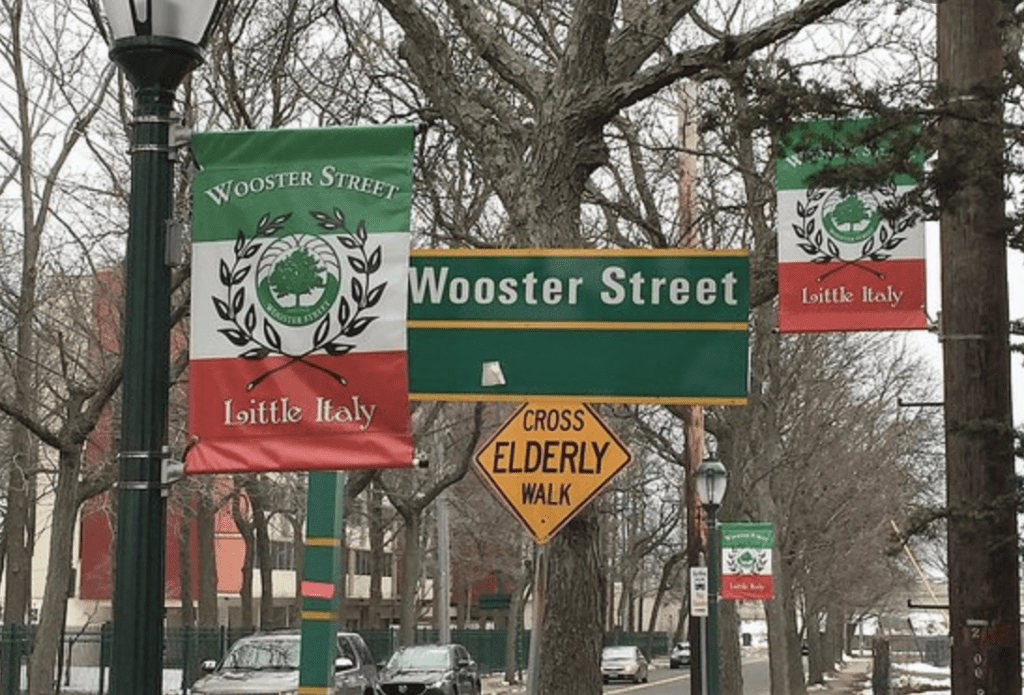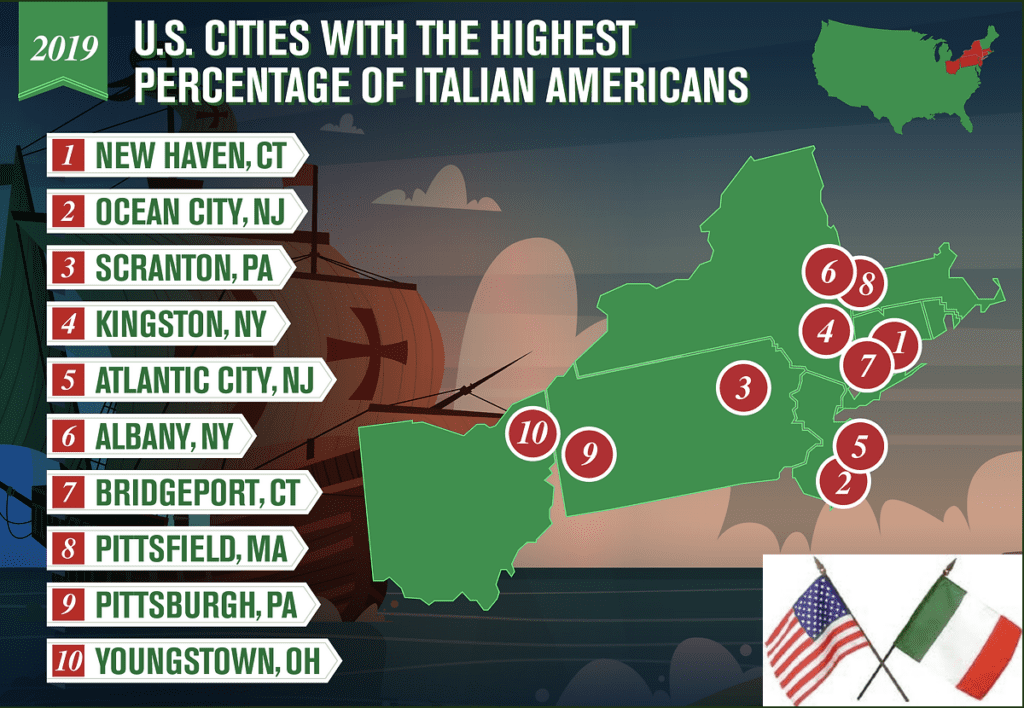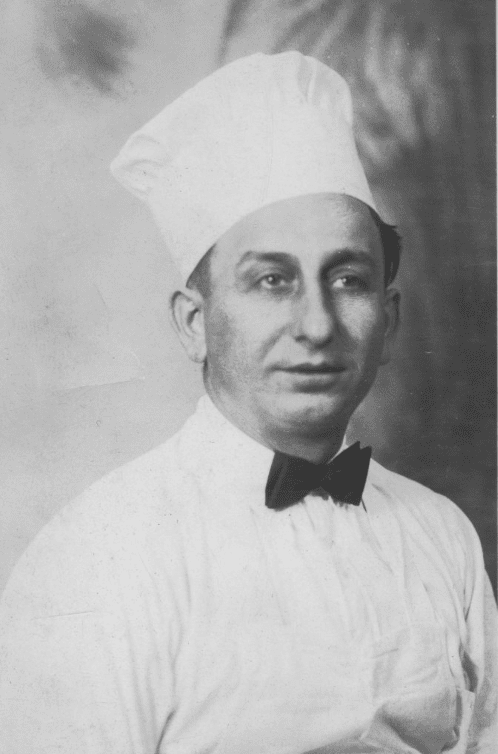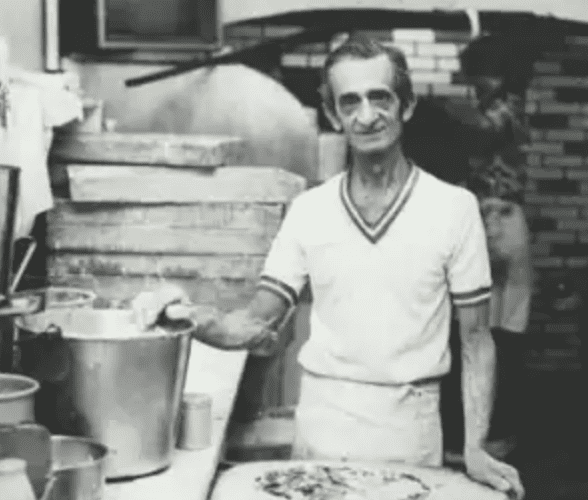How Italian Pizza Came to the US

How Italian Pizza Came to the US – Anthony Riccio explains that at the beginning of the twentieth century, Wooster Square was home to many wealthy aristocrats and merchants from Ireland, Poland, Lithuania and so on.
The influx of Italian immigrants, especially from Amalfi, at the turn of the century, changed the composition of the neighborhood.
This had a lasting impact on the neighborhood, on the history of Italian Americans in New Haven, and naturally, on the food sold in New England.
How Italian Pizza Came to the US – The development of the square occurred primarily between the years 1830 and 1870.
Some of the most notable buildings in the area were erected in the 1840s and are the work of the well known New Haven architect Henry Austin.
Wooster Square’s claim-to-fame was its coal-fired brick ovens that they still use today to make their pizzas.

The beginning of the twentieth century brought an intensification of Italian immigration nationwide. Connecticut’s Italian immigration increased proportionally.
How Italian Pizza Came to the US – Job opportunities across the Atlantic attracted Italian immigrants.
In fact, it is said that America’s most intense period of industrial growth was the catalyst for U.S. employers to seek and sponsor Italian immigrants to come to the New Haven to fulfill many jobs that were needed to keep up with global demand for products.

Many Italians Settled in New Haven
Many Italians settled in Connecticut’s urban centers of Bridgeport, Hartford, New Britain, New Haven, and Waterbury as that’s where many jobs were located.
New Haven again would rank first with more than 27,000 Italian American children in 1930; Waterbury would have about 14,500; Bridgeport’s total would surpass 13,000 and Hartford’s 12,000 by the same year.
New Haven employed them at J.B. Sargent’s metal factory and on the rail line connecting Boston to New York. Waterbury, known as la citta dell’ ontone (the city of brass), retained them in brass factories such as the Scovill Manufacturing Company.
Italians produced metal and tool objects at Hartford’s Fenn Manufacturing Company.
They performed similar tasks at New Britain’s City Coal and Work Company. Middletown’s Frisbie Motors employed Italians to make motor boat engines.
They also dug trenches in the trolley road connecting New Britain to Meriden. Italian men and women in each major city, moreover, worked in the garment, shoe, silk, and rubber industries.
Not all Italians worked as unskilled manual laborers.
How Italian Pizza Came to the US – As the nineteenth century ended, thousands of Italians entered Connecticut from small Italian villages, especially south of Rome.
The Sicilian towns Catania, Mellili, and Siracusa and mainland towns Abruzzi e Molise and Calabria were common points of departure.
New Haven, the state’s largest Italian colony, had more than 13,000 in 1910; Waterbury was second with just over 9,000; Bridgeport ranked third with nearly 9,000; and Hartford fourth with about 7,000.
Italians also formed sizeable communities in New Britain, Middletown, and Stamford.
How Italian Pizza Came to the US – Unmarried young men constituted the most numerous group within the state’s Italian population.
They entered into marriage slowly but then had children quickly.
The second-generation multiplied.
A powerful few became middle-class prominenti (elite), especially those who edited newspapers and founded Italian American associations.
Connecticut’s Italian press established Il Corriere di New Haven, Il Progresso di Waterbury, La Tribuna di Hartford and dozens more newspapers through the 1920s.
Real Italian Pizza in The US Started in New Haven, CT
Way back in 1925, an ambitious Frank Pepe opened the first pizza restaurant on Wooster Street.
Modern was the next to open its doors in 1934, and the New Haven pizza revolution was officially underway! After watching the success of his uncle, Frank Pepe’s nephew would go on to start Sally’s Apizza down the street in 1938.
These three have created what most feel is the holy trinity of pizza places in New Haven.
The Neapolitan style thin crust is cooked in coal-fired brick ovens, which gives it its now famous char on the bottom.
Frank Pepe’s and Sally’s still use the coal fire method to this day! You may notice Modern and Sally’s added the “A” on the front of the word pizza creating what sounds like the most Italian word ever in “Apizza.”
This is part of a dialect of the Italian language only used in Naples.
How Italian Pizza Came to the US – Apizza, Not Pizza
There is pizza, and then there is apizza. New Haven-style pizza is the latter; a hotter, crispier, and dirtier descendant of Neapolitan style pie.
You might’ve noticed that New Haven pizza’s got its own name — apizza.
It’s pronounced “ah-beets”, and it’s derived from the Italian dialect of the Neapolitan immigrants who first settled there.
Since the people making the pizzas were from the area around Naples, the pizza tends to skew toward the stylings of the original Italian pizzaiolos.
The name “apizza” is a nod to the dialect of the Neapolitan immigrants who first brought pizza to the region.
It’s one of the many ways that New Haven-style pizza stays close to its roots, along with the chewy crust, minimalistic tomato sauce, and lighter touch of cheese.
How Italian Pizza Came to the US – Pizza Rules
One: it’s all about the charred sides of the pizza, the blackened result of rotating dough in a very hot, wood-fired oven.
Two: a pizza joint is only as good as its cheese pie.
Three: a plain pie means straight up tomato sauce, maybe a little romano, and some basil and garlic. Add mozzarella, and it’s no longer a plain pie.
Italian Pizza Pioneers Brought Pizza to The US
Two restaurants are credited with establishing New Haven as a pizza city: Frank Pepe Pizzeria Napoletana and Sally’s Apizza, each started by an Italian immigrant.
New Haven-style pizza is a style of thin-crust, coal-fired Neapolitan pizza common in and around New Haven, Connecticut.
What makes New Haven-style pizza distinct is its thin, oblong crust, characteristic charring, chewy texture, and limited use of melting cheeses.
In a New Haven-style pizzeria, a “plain” pizza is a crust, oregano, tomato sauce, and a little bit of grated pecorino romano cheese. A “plain” New Haven-style pizza may also be called a “tomato pie”. Mozzarella is considered a topping.
New Haven-style pizza is traditionally baked in a coal-fired oven at extremely hot temperatures above 650 °F (343 °C). It is sold whole rather than by the slice.
Their stories are know in some form by the thousands of people who have eaten a slice of New Haven history.
This geographically limited pizza style has been favorably regarded by national critics.

How Italian Pizza Came to the US – Pizza Legend Frank Pepe
Frank Pepe, born in Maiori on Italy’s Amalfi Coast, immigrated at 16 to the U.S. in 1909, getting his first job in a New Haven factory.
Pepe came to America, poor and unable to read or write, in 1909 at age 16.
He returned to his native Italy to fight in WWI, but came back to New Haven in 1920, newly wed to Filomena Volpi.
Pepe worked at a macaroni factory on Wooster Street before opening his own bakery on the same street in New Haven’s “Little Italy” neighborhood.
He baked his bread and delivered it to the community with a cart, but since Pepe was illiterate, he couldn’t keep track of the orders, so he opened a store where customers would come to him.
He and his wife began making a simple recipe from their country — pizza, known to them as “apizza” in their Neapolitan dialect.
Pepe began walking through the Wooster Square market and sold his “tomato pies” off of a special headdress.
They started baking their signature pizza in 1925 with tomatoes, grated cheese, garlic, oregano and olive oil, offering a second type with anchovy.
After saving enough money, he was able to buy a wagon from which he sold his pizzas.
He was so successful that he was eventually able to take over his employer’s business and turn it into the first “Frank Pepe Pizzeria Napoletana” on June 16, 1925.
“When he opened it was just takeout, but it grew rapidly and expanded business inside with sit-down tables,” Pepe’s grandson Gary Bimonte said. “He was one of the first to offer the sit-down restaurant.”
Pepe’s restaurant is credited with inventing the “white clam pie”, a pizza of crust, olive oil, oregano, grated cheese, chopped garlic, and fresh littleneck clams. It served littleneck clams on the half shell at the bar, which Pepe later added to the pizza.
Pepe’s was and has remained a family business. In his restaurant is where Pepe’s nephew Salvatore “Sal” Consiglio learned pizza-making.
Pepe’s served apizzas to former presidents Ronald Reagan and Bill Clinton, along with Tony Bennett, Bill Murray, Gene Siskel, Meryl Streep and Danny DeVito.
Frank Pepe died on September 6, 1969.

How Italian Pizza Came to the US – Pepe’s Nephew Salvatore “Sal” Consiglio
When Pepe moved his pizzeria to its current location in 1937, Consiglio struck out on his own, opening Sally’s Apizza down the street in 1938.
The restaurant was purchased for $500 in 1938 by Filomena Consiglio, sister of Frank Pepe, who was the owner of Frank Pepe Pizzeria Napoletana, another Wooster Street pizza restaurant.
Sal Consiglio, a son of Filomena, ran it until his death in May 1989.
Sally’s Pizza is renowned for thin crust pizza still baked today in the same coal-fired oven that has been in use for over 75 years.
They, too, served a traditional tomato pie.
Sal Consiglio’s parents, Gennaro, a fisherman from Amalfi, Italy, and Filomena, from Maori, met in New Haven and Sal was born on Chestnut Street.
He began working at age 6 hawking New Haven Registers.
By age 8, Sal started working for Pepe and was ready by the time Pepe’s moved in 1937 to a newer, larger location next door at 157 Wooster St. to strike out on his own.
So in 1938, with a $600 loan from his mom and her recipe for a thin-crust apizza, he opened his own pizzeria a block or so away at 237 Wooster Street aand the friendly rivalry that in many ways defines New Haven was born.
Sal was joined a few years later by his wife, Flo Consiglio.
Sally’s can count Clinton, former Vice President Al Gore, former Gov. Lowell Weicker, Glenn Miller, Doonesbury cartoonist Garry Trudeau, Jodi Foster, Michael Bolton and Frank Sinatra, among its patrons.
Sally’s was operated as a family run business since 1938 and was one of the oldest family run pizzerias in the Northeast.
The Top Three Italian Pizzerias In New Haven CT
There are only three pizza places in the world that matter.
Most everyone has a passion for pizza, but only New Haven lays claim to the Holy Trinity of pizza joints with Sally’s, Pepe’s, and Modern.
They are not only a cornerstone of New Haven’s Italian-American heritage but also the establishments that set the bar for this immediately recognizable comfort food.
National polls agree: these are the pizzas by which all others are measured.
Three families bequeathed New Haven with a hat trick of Italian American pizza parlors and a legacy that inspires imitation.
Frank Pepe Pizzeria Napoletana, known simply as Pepe’s, was the first to open on Wooster Street in 1925, Modern Apizza opened on State Street in 1934, followed by Sally’s Apizza on Wooster Street in 1938.
As pizzerias come and go, none have risen to the level of these big three
Pizza is the most loved food in America and it’s not really even called pizza.
Here’s a story about three pizza places in the town of New Haven, Connecticut that put pizza on the map in the US and you have probably heard of any of them – Sally’s Apizza, Frank Pepe’s Pizzeria Napoletana, and Modern Apizza, and they are generally considered to be three of the finest pizza restaurants on the planet.

Pepe’s Pizzeria Napoletana
Founded: 1925
Oven: Coal-fired brick oven
Signature Pizza: White clam pizza
Pie style: Uneven round
Slice style: Asymmetrical wedges
Location: 157 Wooster Street, New Haven, CT
(203) 865-5762
pepespizzeria.com
The original. The big dog.
All other New Haven pizzerias are in the shadow of Pepe’s, and they know it.
In addition to the original coal-fired location on Wooster Street, it’s expanded into several other Connecticut towns, Yonkers, NY, and area casino Mohegan Sun.
Lines at the first location are often discouragingly long and cutthroat.
Their white clam pie is legendary (shucked fresh in-house daily), and pairs well with their thick-cut bacon.
Synonymous with New Haven pizza, Frank Pepe Pizzeria Napoletana is the granddaddy of New Haven’s pizza scene. From its humble beginnings on Wooster Street in 1925, Pepe’s has recently expanded to five additional locations in Connecticut and New York.
Although much time and expense has gone into duplicating the taste and feel of the Pepe’s experience, none come close to the experience of the original Pepe’s location in New Haven.
The original Pepe’s is now called The Spot, located to the left and rear of where Pepe’s stands today on Wooster Street. It is home to a smaller, nearly identical operation with shorter lines, but Pepe’s proper is still the main draw.
Two dining rooms are continually filled to the brim, often with long lines trailing down the block.
Inside, a massive and deep brick oven with a white-tiled facade stands at attention in the rear, attended by white-aproned men wielding impossibly long peels and pounding out their over-sized oblong pies.
Pepe’s very first pizzas were tomato pies, and a nod to these modest roots can be found in the constantly-lit “Original Tomato Pie” neon sign hanging above the kitchen’s counter. Its most beloved pizza is the famous original white clam pie.
Hundreds of imitators have attempted to match the intoxicating combination of romano cheese, fresh garlic, olive oil, parsley, and clams atop the chewy and charred oblong pies.
Clam Pizza Pro Tip
Add bacon. Pepe’s is known for its intensely smoked bacon, which remains pliable and similar in texture to the clams, making it an excellent partner in crime.

Sally’s Apizza
Founded: 1938
Oven: Coal-powered brick oven
Signature Pizza: Tomato pie, Garden pie
Pie style: Uneven round
Slice style: Asymmetrical wedges
Location: 237 Wooster Street, New Haven CT 06511
sallysapizza.net
(203) 624-5271
Notes: Cash only
Frank Sinatra was a Sally’s guy. And really, that’s all you need to know.
Very little has changed at Sally’s since Salvatore Consiglio first started serving pies out of its coal-fired oven in 1938 on Wooster Street.
The Consiglio family is still the keeper of the Sally’s flame, and Salvatore Consiglio’s two sons, Richard and Bobby, continue to make the pies and wield the peels daily.
This rare fidelity translates to a consistency that sets Sally’s apart from any of its New Haven peers.
The pizza you ate on your first visit will likely be identical to the pizza you eat on your next visit, which is likely similar to the pizza that Ol’ Blue Eyes ate back in the day.
Lined with wood paneling, Sally’s dining room reflects decades of accumulated memorabilia, leading to the controlled chaos that is the rear open kitchen.
The white and red brick oven façade is smudged with soot, containers and receipts are piled precariously on surfaces, and service is, well, almost nonexistent.
According to Bobby Consiglio, Sally’s burns through about a ton of coal each week.
One thing that is for certain, the Sally’s tomato pie reigns supreme on Wooster Street.
It’s the benchmark for which any tomato pie is measured, thanks in part to a house-made tomato sauce with a proprietary blend of tomatoes.
An evenly crispy and charred edge, a tangy layer of tomato sauce that approaches the pizza’s flat edge, and a smattering of fresh herbs with nary a fleck of cheese in sight, prove simple is better and decades of ritual matter.
In the summer, Sally’s offers a fresh tomato version with fresh basil and a light smattering of cheeses.
Anther pie that is nearly as good and unique to Sally’s is the Garden Special, a combination of tomato, mozzarella, zucchini, and basil.
Sally’s well-worn patina and a gruff eccentricity polarize customers, offending some while charming others.
Unlike Pepe’s, which has dusted itself off and expanded, Sally’s has remained defiantly focused and unchanged by the Consiglio family for the past 76 years.
This may be the root of the rivalry between these two similar, yet vastly different New Haven apizza parlors.

Modern Apizza
Founded: 1934
Oven: Open flame brick oven (originally coke-fueled).
Signature Pizza: The Italian Bomb
Location: 4 State Street, New Haven, CT
(203) 776-5306
modernapizza.com
Located on State Street in the East Rock neighborhood, Modern Apizza sits just off the well-beaten path of Wooster Street, earning its status within New Haven’s pizza scene with an 80-year history and an adherence to apizza tradition.
Slightly less well-known than the other two giants (meaning shorter lines), Modern is more of a local joint that specializes in wood-fired pizzas — as opposed to the coal-fired ones of Sally’s and Pepe’s — with a smattering of fresh, artisanal toppings.
Their Italian bomb pie (bacon, sausage, pepperoni, mushroom, onion, garlic, peppers) is a tour de force.
Modern’s owner Bill Pustari — who purchased Modern from its original owner over thirty years ago — has worked hard to build its reputation because of its location.
As a result, it’s known as the most welcoming and family-friendly of the big three.
Its signature pie is known as the Italian Bomb.
Modern’s open flame brick oven cranks out charred, chewy, and substantial pizzas.
The more toppings the merrier.
The crust is one of the more interesting for New Haven apizza, thanks to the unique texture of its undercarriage.
While some parlors use cornmeal to help pizza slide off the peel, Modern uses a special breadcrumb recipe.
Watch the oven action closely and you’ll see the each pizza touch down on a rough mat before it makes its way into a pizza box, clearing off the remnants.
The thin and chewy Modern crust is the result of dough made from a starter, with just flour, water, yeast, olive oil, and salt, which is then treated to a 24-hour cold fermentation.
Modern does not shy away from its use of cheese, which is a whole milk aged mozzarella, and every Modern pie is finished with a hit of Pecorino Romano.
The sauce is made of whole hand-crushed Italian peeled tomatoes, often purchased by the lot to ensure consistency and cooks only during its time within the oven.
Setting it apart from its more sparsely topped neighbors and classic pies, Modern’s best-known pie has become known as the Italian Bomb, a monster with seven toppings: Sausage, bacon, pepperoni, onion, mushrooms and garlic, made possible by a sturdy crust and sparse “mootz.”
The underdog of New Haven’s pizza scene, Modern owns the title of “friendliest” joint and heftiest pizza, as well as one of the few places you can usually avoid a long wait.
How Italian Pizza Came to the US – How New Haven Natives Order a Pizza
The word “apizza” is itself a distinguishing characteristic of New Haven.
The “a” is a harbinger of the Italian dialect spoken in the Naples region.
Sally’s and Modern still use it proudly and a handful of places in the region use it as a deferential nod to their stylistic New Haven roots.

New Haven Pizza Terms
It’s apizza, not pizza.
The Southern Italian influence also explains how apizza, the word for the thin-crust pie that Frank Pepe brought to these part, came to be pronounced “ah-BEETZ.
Coal
In the twenties and thirties coal was abundant and cheap. It is also still responsible for the blistered, sooty, and smoke-imbued flavor of the pies at Pepe’s and Sally’s. Modern also initially relied on coal, in the form of coke fuel, but has long-since turned to an oil-fueled open flame brick oven.
It’s Not Burned, It’s Charred
What all apizza has in common, regardless of the fuel source, is intensely hot brick ovens, and pies left intentionally longer on their decks, producing a signature deeply charred crust.
Some may call it burned, but that’s wrong: In New Haven, it’s charred.
A Long, Cold Fermentation
New Haven-style pizza dough relies on a longer fermentation than that of its quick rise New York style pizza neighbor.
Allowing the dough to proof more slowly over the course of an overnight refrigeration, in combination with letting the dough come to room temperature before shaping and baking, allows for a much more nuanced flavor and chewy crust.
“Mootz”
Most of the old timers in New Haven call their whole milk aged mozzarella by a single syllable: “mootz.”
You can get away with this on or around Wooster Street if you 1) grew up using the word 2) are Italian American and want to give it a go, or 3) work in a pizzeria and/or have some flour on your shirt.
“Mootz” is a topping
Mozzarella is considered a topping so always be sure to specify “mootz” or “no mootz.” If you don’t ask for it, it won’t come on your pizza.
Tomato Pies
The first pies made in New Haven were topped with tomato sauce.
That’s it.
No rivers of cheese, nary a topping in sight, just fresh and tangy hand crushed tomatoes cooked simply by the heat of the oven. Die-hards still prefer light or no cheese to appreciate the simplicity of New Haven’s tangy tomato sauce and charred crust, and today almost all New Haven pizza parlors have their own take.
White Clam Pizza
Any New Haven pizza parlor worthy of its zip code makes a decent white clam pie. They should, after all: Pepe’s invented it, and New Haven is a stone’s throw to Long Island Sound.
A combination of clams, with grated aged cheese, and garlic atop a thin crust is at the top of its game when paired with their smoky bacon.
Foxon Park Soda
Although technically not really part of the pizza, these pops are very much part of the New Haven experience.
Foxon Park sodas are ubiquitous at the big three, a product that’s has been manufactured in East Haven since the 1922.
Made using real sugar, they’re known for their White Birch flavor.



